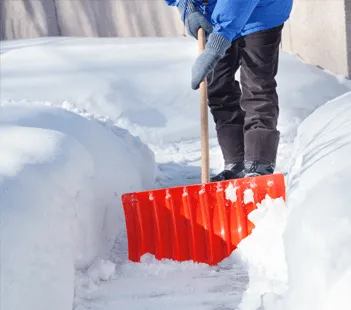January 01, 2017

Snow Thrower Safety
Snow throwers are wonderful devices for helping us clear away the heavy Colorado snow. However, they can also cause serious injuries. The Orthopedic Experts at Denver Health encourage you to be smart when using these powerful tools.
Each year, thousands of people suffer deep cuts, loss of fingers and toes, crushed and broken bones, joint injuries, burns, infections, other injuries, and even death due to improper or careless or improper use of snow blowers. Injuries happen to people from all age groups, but adults between the ages of 25 and 64 years are at the greatest risk.
Injuries most frequently occur when consumers try to clear the auger/collector or discharge chute with their hands.
Prevent snow thrower injuries:
- Avoid sticking hands in a snow thrower. If snow jams the machine, stop the engine and wait more than 10 seconds. Use a solid object to clear wet snow or debris from the chute. Beware of the recoil of the motor and blades after the machine has been turned off.
- Proper supervision. Do not leave the snow blower unattended when it is running. Shut off the engine if you must walk away from the machine. Avoid leaving the snow blower unattended when it is running. Avoid running the machine running in an enclosed area.
- Be smart when refueling. Add fuel before starting the snow blower. Never add fuel when the engine is running or hot. Do not operate the machine in an enclosed area.
- Avoid the engine. Stay away from the engine. It can become very hot and burn you.
- Watch the snow thrower. If you are operating an electric snow blower, be aware of where the power cord is at all times.
- Avoid tampering. Do not remove safety devices, shields, or guards on switches, and keep hands and feet away from moving parts.
- Watch for motor recoil. Beware of the brief recoil of motor and blades that occurs after the machine has been turned off.
- Keep children away. Never let children operate snow thrower. Keep children 15 years of age and younger away when snow throwers are in use.
- Wear eye protection. Snow throwers often throw debris, rocks and ice chunks.
- Understand your machine. Read the instruction manual prior to using a snow thrower. Be familiar with the specific safety hazards and unfamiliar features. Do not attempt to repair or maintain the snow thrower.
The Orthopedic Experts at Denver Health provide 24/7/365 trauma care for hand and microvascular injuries, offering one of Rocky Mountain region’s leading reconstructive programs. Focusing on acute trauma to extremities, our surgeons have many documented successes for reattachment/ revascularization of limbs following motor vehicle, farming, industrial, rodeo accidents, recreational mishaps, and snow thrower and lawnmower accidents.
Download Snow Thrower Safety Tips PDF
Source: National Electronic Injury Surveillance Systems of the U.S. Consumer Product Safety Commission (CPSC) data.
© 2012 Denver Health

